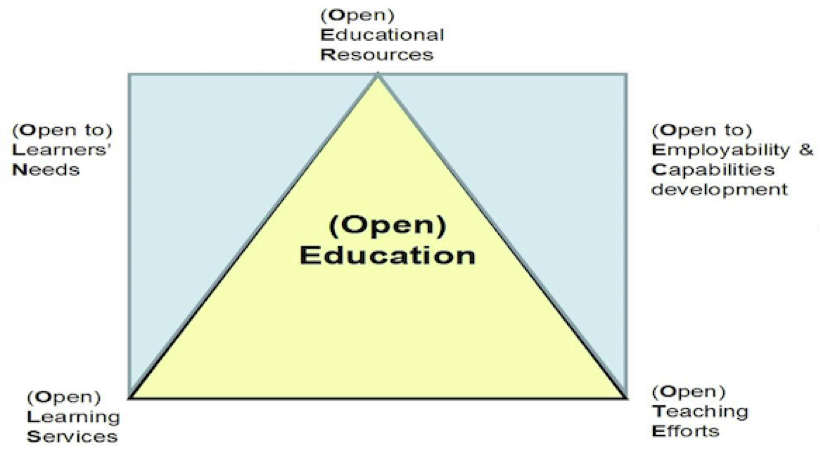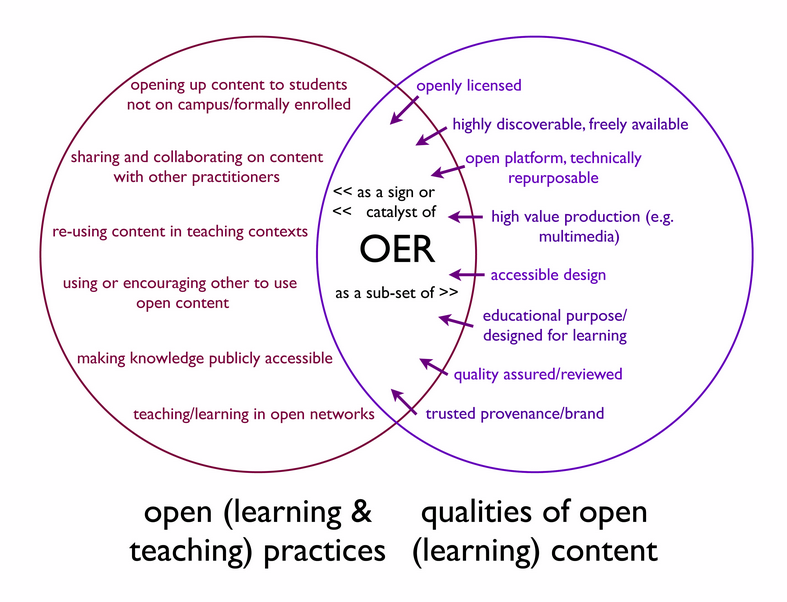Open Learning
Summary is prepared using Training material of ReOpen project
2. Characteristics of Open learning

Figure 2: Five characteristics of open education
The term can refer to two different activities:- Activities that widen learning opportunities
beyond a formal education system or
- Activities that improve learning opportunities within a formal education system.
There is no unified and comprehensive definition of "open learning". Still, the focus is usually on the learner's needs that the learner perceives (Coffey, 1988).
Open learning can be characterized by the following items[1]:
- Learners access free online content;
- Learners enrolling on free open
learning courses;
- Learners collaborating on open
knowledge-building projects (e.g. wikis, web sites);
- Learners who share results with each other;
- Open accreditation or certification is open learning an emerging aspect.
 Figure
3: OER overview[2]
Figure
3: OER overview[2]
One of the main elements of open learning - and perhaps those most interested in - are open educational resources (OER, see also Figure 2). They can be defined as "The open provision of educational resources, enabled by information and communication technologies, for consultation, use and adaptation by a community of users for noncommercial purposes” (UNESCO 2002). However, there are various alternative OER definitions. Figure 3 Illustrated by a variety of OER related topics.
Open learning patterns are confused by the different use of the term to describe educational and learning systems with quite different characteristics and qualities. UNESCO (2002) defines open learning as educational systems in which many aspects of the learning process are managed by the learner. It attempts to provide learning opportunities where, when and how the learner needs them. The attempts to provide learning opportunities indicate the continuum of learner control that defines many of the operational open learning systems. Typically, these characteristics are as follows[3]:
- open admission is required;
- high levels of learner choice
on program curriculum;
- recognition
of prior formal and non-formal learning;
- there is little or no need for
a place and a resident institution;
- continuous enrolment and self-pacing.
In many cases, open learning curriculum is not defined according to a particular curriculum structure, but is considered to be a learning and teaching culture based on common values and beliefs. For example, Brown's university open curriculum is based on three principles: 1) students must be actively involved in the education process, assuming responsibility for their learning direction; 2) learning is considered as an individual and intellectual development process; 3) the content of education should promote individuality, experimentation, integration and synthesis of various disciplines[4].
Open learning refers to any educational activity in which learners are separated from the faculty and other learners. The development of open learning was possible through the development of information and communication technologies. Students and their teachers may be in one or more countries. Open learning courses may or may not require physical presence on grounds such as taking examinations or defending a thesis.
The main trend in research on open online learning is directed towards massive open online courses (MOOCs) studying it as innovative pedagogy, searching for quality, different aspects of students behavior (Onah, Sinclair, Boyatt, 2014; McAndrew, Scanlon, 2013). Witthaus, Inamorato dos Santos, Childs, Tannhäuser, Conole, Nkuyubwatsi, Punie, (2016) analyzing assessment and recognition practices in Europe and particularly Mooc- based learning pointed out on need of further research into the Member States' regulations and practices would enable the setting up of specific strategies for advancing the recognition of open education in Europe.
While research on Open Online Learning reveals different aspects and roles of HE the student lifelong learning model should not be restricted to the traditional students; non-traditional groups should benefit as much from open online learning. An institution will reach its goals by providing services that will enhance the learners’ chances of success instead of leaving them to sink or swim. The complexity of research starting from need analyses for open online learning, teacher competences to provide such learning, students behavior’s analysis and recognition of open online learning achievements have not been studied yet.